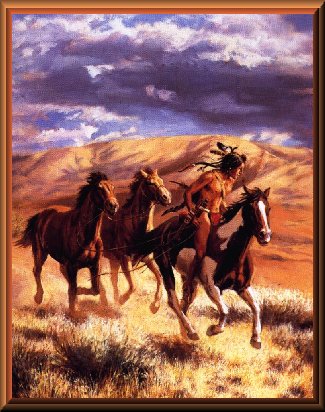

Prior to the introduction of the horse by the Spaniards in the 1540s
the inhabitants of the Great Plains led a pedestrian, nomadic existence.
As the horse spread from the south, by trade or capture, Plains culture
flowered. Some ancient occupants of the Northern Plains, such as the
Shoshone and Kutenai, were gradually driven out as more powerful
and now gun-carrying Blackfeet and other tribes pushed in from the
north and east, motivated by the knowledge that a vast, rich domain
would be theirs, if the gun and horse could be combined. Similarly, on
the Southern Plains the horse-wealthy Comanche, with guns obtained
from French allies, forced the Padouca off the Plains of Texas.

Although influenced by the Spanish, a distinctive Plains style of
saddle, bridle, martingale and stirrup emerged, beautifully decorated
with porcupine quills and beads; some of the finest women's horse
accountrements were made by the Crow.

The effects of the horse on the Plains people were profound. Using the
larger, horse-drawn travois with its load-carrying platform, tipi
covers and furnishings could be transported, more possessions acquired
and greater distances travelled. More than anything, however, the vast
herds of buffalo, offering plenty and prosperity, became readily accessible
and relatively easy game.




© Background by Detiny's Lady